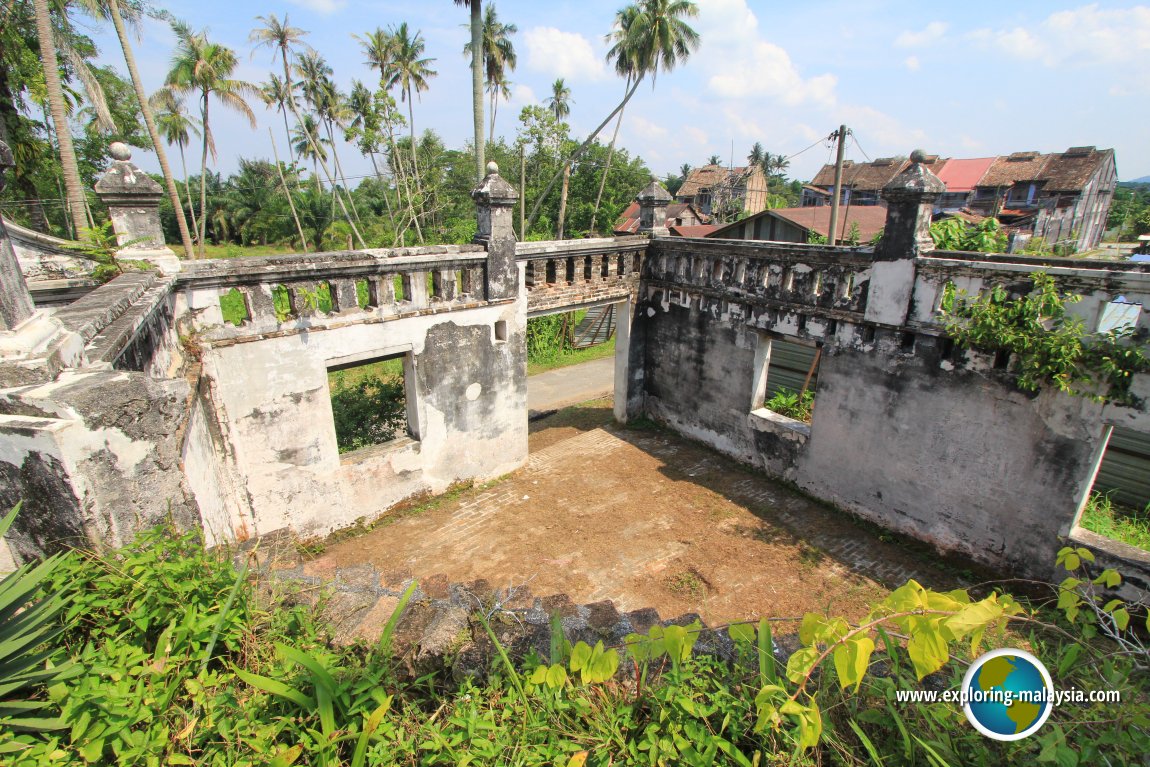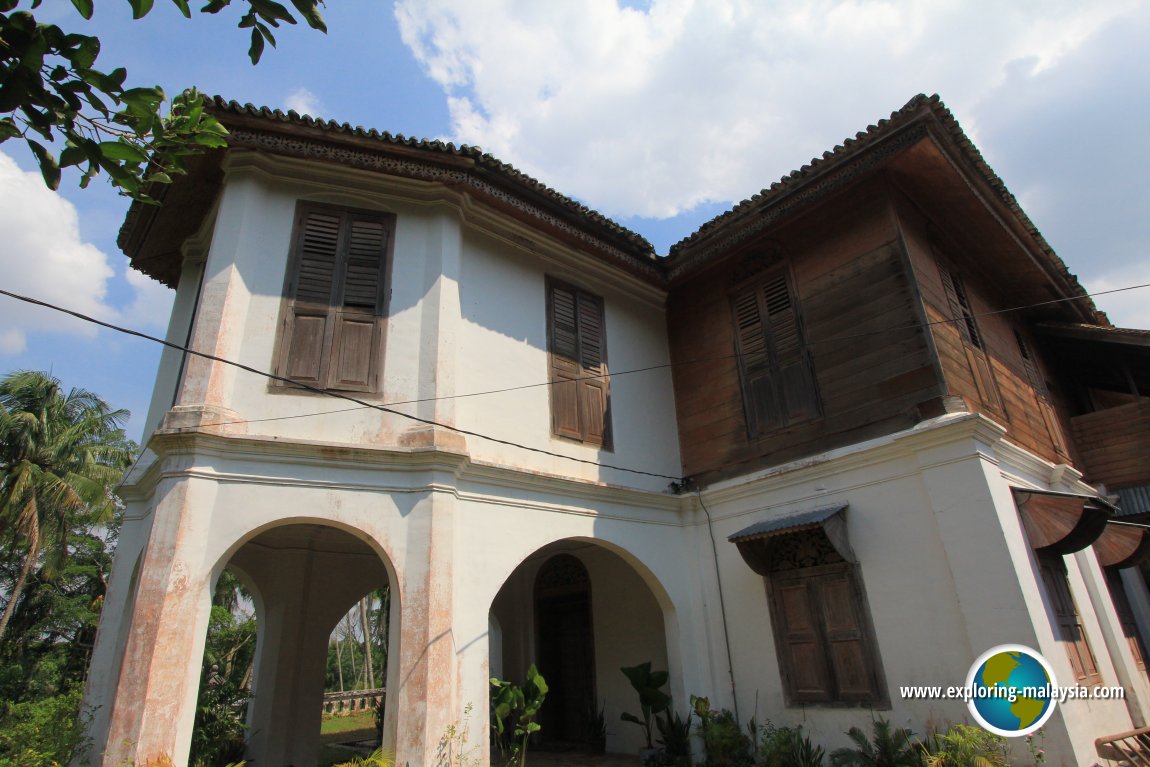 Rumah Besar Raja Bilah (18 June, 2011)
Rumah Besar Raja Bilah (18 June, 2011)
Rumah Besar Raja Bilah (GPS: 4.51534, 101.0129) the residence of the Mandailing Raja or Namora in Papan, Perak. Also known in Mandailing as Bagas Godang (meaning "great house"), it is one of the most majestic buildings in Papan.
The Mandailing is an ethnic group distinct from the Malays. Originating from Sumatra, many of them came to Malaya in the 19th century, though there may have been Mandailing communities in Malaya earlier than that. Within the Mandailing are clans such as Batubara, Daliminte, Daelae, Harahap, Hasibuan, Lintang, Mardia, Matondang, Nasution, Parinduri, Pulungan, Rangkuti, Tambak and Tanjung.
In writing this article, I sought the assistance of Namora Sende Loebis (@ Abdur-Razzaq Lubis). He is the Mandailing All Clans Assembly representative for Malaysia and Singapore. According to Namora Sende Loebis, the Rumah Besar is the residence of the Mandailing Raja or Namora. (The term namora is in the singular for nobility while namora-mora is the plural.)
Rumah Besar was built by Raja Bilah in 1896. The year can be seen on the archway as you climb the stairs towards the house. It was built fourteen years after Raja Bilah built own residence, Rumah Asal, located right next door. Rumah Besar was built to mark the formation of the Federated Malay States which comprised Perak, Selangor, Pahang and Negri Sembilan. Raja Bilah was the founder of the Mandailing settlement in Papan. Born in Maga in Mandailing Julu (Upper Mandailing), in the Mandailing homeland of Sumatra in 1834, he was the nephew of Raja Asal, the Mandailing overlord who founded the Mandailing settlement in Pangkalan Kacha, now known as Changkat Piatu.
I originally wrote that before the 19th century, the Mandailing were Hindus or practised an indigenous religion, Parmalim. However, according to Namora Sende Loebis, the Mandailing were never Hindus nor were they ever Parmalim. He informed me that the Parmalim movement, whose members were drawn mostly from the Tobas people, was based on a set of belief systems that are anti-Dutch and anti-Christian missions. Instead the Mandailing practised a form of ancestral veneration called pele begu.
 Archway at the grand staircase leading up to Rumah Besar Raja Bilah (18 June, 2011)
Archway at the grand staircase leading up to Rumah Besar Raja Bilah (18 June, 2011)
 The archway, as seen from the other side (18 June, 2011)
The archway, as seen from the other side (18 June, 2011)
By the 19th century, they had converted to Islam and embraced Muslim culture. I wrote that there may have been a degree of hostility or animosity with the neighbouring Minangkabau people who may have encroached, invaded or conquered their land, forcing many Mandailings to move away. According to Namora Sende Loebis, they were indeed forced to convert to Islam at the point of the sword, after being vanquished in the Padri War of 1821-1837. It created the Mandailing diaspora, and may be the reason why Raja Bilah and his clan relocated to the Malay peninsula.
Raja Bilah and his family relocated to Papan, Perak, in 1877. The Mandailing community initially settled at nearby Pengkalan Kacha, presently known as Changkat Piatu. As Papan grew with tin mining, Raja Bilah decided to relocate there, and to involve himself in the lucrative tin trade.
 Remains of the walls at Rumah Besar Raja Bilah (18 June, 2011)
Remains of the walls at Rumah Besar Raja Bilah (18 June, 2011)
 A compound surrounded by the retaining wall, Rumah Besar Raja Bilah (18 June, 2011)
A compound surrounded by the retaining wall, Rumah Besar Raja Bilah (18 June, 2011)
At one time, Papan had a substantial Mandailing community in Malaya - the biggest Mandailing community, according to Namora Sende Loebis, is probably the one in Ulu Langat, Selangor. By the time Rumah Besar was erected, however, many of the Sumatran and Javanese miners have moved away, leaving only the Mandailing clan clustered around Masjid Kampung Papan, which is located on a slope, a stone's throw from the Rumah Besar. Rumah Besar is not so much a residence (Raja Bilah stays next to it at Rumah Asal) but rather a clan house, a place where Mandailing clansmen gather.
Chinese craftsmen were employed in the construction of Rumah Besar. The main hall has octagonal columns, said to represent clan unity from all cardinal points. I had earlier mentioned that Rumah Besar was built by a Chinese contractor named Ah Hong, of the company Chop Weng Sun. However, Namora Sende Loebis informed me that while Ah Hong did build the six shophouses in Papan for Raja Bilah, there is no evidence to state that he also built Rumah Besar. As for Rumah Asal and Masjid Kampung Papan, they were erected by Mandailing craftsmen in keeping with Mandailing architecture of their homeland.
Located on a knoll overlooking Papan, Rumah Besar affords a splendid view of Papan, where Raja Bilah's six shophouses stood. Unfortunately for him, from this vantage point, he probably got an unblocked view of calamity, when his six shophouses - along with many of the others houses in Papan - were razed by a fire in 1899.
Today Rumah Besar is still standing after over a hundred years. Recently the Department of Heritage and Antiquities carried out restoration work on it. Mandailing clansmen held a gathering at Rumah Besar recently, to celebrate the 100th anniversary of Raja Bilah's demise, on 9 June, 1911. They were entertained by a talk given by Mandailing historian Abdur-Razzaq Lubis, who wrote about the clan's history in Perak, in Raja Bilah and the Mandailings in Perak, 1875-1911.
I had the opportunity of visiting Rumah Besar Raja Bilah, in the company of the Vice President of the Perak Heritage Society, who provided me a glimpse of the Mandailing history.
 Peeking in at the interior of Rumah Besar Raja Bilah - in appears housekeeping is in order. (18 June, 2011)
Peeking in at the interior of Rumah Besar Raja Bilah - in appears housekeeping is in order. (18 June, 2011)
 View of Rumah Besar Raja Bilah from the side (18 June, 2011)
View of Rumah Besar Raja Bilah from the side (18 June, 2011)
 Side view of Rumah Besar Raja Bilah (18 June, 2011)
Side view of Rumah Besar Raja Bilah (18 June, 2011)
Rumah Besar Raja Bilah is  on the Map of Papan
on the Map of Papan
Acknowledgement
Exploring Malaysia expresses thanks to Law Siak Hong for helping visiting this house, and Namora Sende Loebis for graciously reviewing and commenting on the information provided in this article.BIBLIOGRAPHY
Raja Bilah and the Mandailings in Perak, 1875-1911, by Abdur-Razzaq Lubis & Khoo Salma NasutionISBN: 967-9948-31-5
Kinta Valley: Pioneering Malaysia's Modern Development, by Khoo Salma Nasution & Abdur-Razzaq Lubis
ISBN: 983-42113-09
List of Historic Buildings in Papan, Historic Buildings in Perak and Historic Buildings in Malaysia
 Latest updates on Penang Travel Tips
Latest updates on Penang Travel Tips
 Map of Roads in Penang
Map of Roads in Penang
Looking for information on Penang? Use this Map of Roads in Penang to zoom in on information about Penang, brought to you road by road.Disclaimer
Please use the information on this page as guidance only. The author endeavours to update the information on this page from time to time, but regrets any inaccuracies if there be any.
Copyright © 2003-2025 Timothy Tye. All Rights Reserved.

 Go Back
Go Back